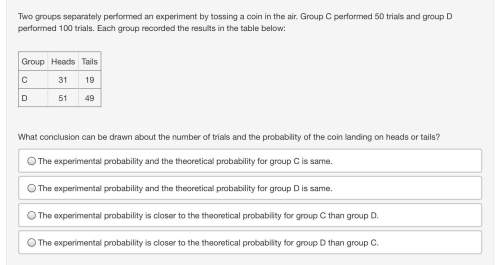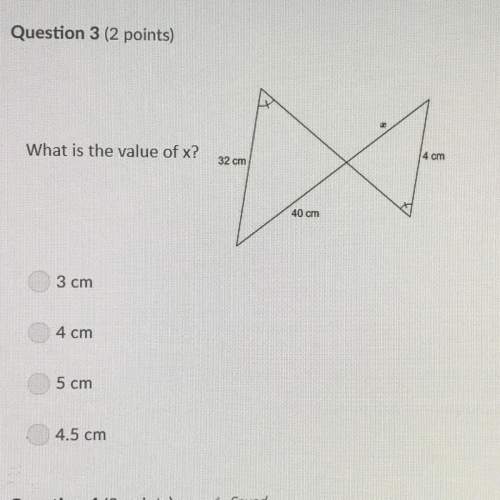
Mathematics, 09.07.2019 01:20 wwwcarolynzouowficz
Two groups separately performed an experiment by tossing a coin in the air. group c performed 50 trials and group d performed 100 trials. each group recorded the results in the table below:
group heads tails
c 31 19
d 51 49
what conclusion can be drawn about the number of trials and the probability of the coin landing on heads or tails?
the experimental probability and the theoretical probability for group c is same.
the experimental probability and the theoretical probability for group d is same.
the experimental probability is closer to the theoretical probability for group c than group d.
the experimental probability is closer to the theoretical probability for group d than group c.


Answers: 1
Another question on Mathematics

Mathematics, 21.06.2019 13:00
You download a video game to your computer. you have a 60-minute free trial of the game. it takes 5 1/6 minutes to set up the game 7 1/3 minutes to play each level. you want to find out how many levels you can play for free.which inequality describes the number of levels, l, you can play in 60 minutes? can you play 6 levels during your free trial? i need ,
Answers: 3

Mathematics, 21.06.2019 19:00
Me asap on # : explain how factoring a trinomial, ax^2+ bx+ c, when a does not equal 1 different from factoring a trinomial when a = 1.
Answers: 2

Mathematics, 21.06.2019 20:30
Ateacher brought a pack of 17 batteries . each calculator uses 3 batteries . how many calculator can the teacher fill with batteries
Answers: 2

Mathematics, 22.06.2019 04:10
The probability that a u.s. resident has traveled to canada is 0.18 and to mexico is 0.09. a. if traveling to canada and traveling to mexico are independent events, what is the probability that a randomly-selected person has traveled to both? (page 109 in the book may ) b. it turns out that only 4% of u.s. residents have traveled to both countries. comparing this with your answer to part a, are the events independent? explain why or why not. (page 119 may ) c. using the %’s given, make a venn diagram to display this information. (don’t use your answer to part a.) d. using the conditional probability formula (page 114 in the book) and the %’s given, find the probability that a randomly-selected person has traveled to canada, if we know they have traveled to mexico.
Answers: 3
You know the right answer?
Two groups separately performed an experiment by tossing a coin in the air. group c performed 50 tri...
Questions



Mathematics, 22.01.2021 23:40

Mathematics, 22.01.2021 23:40


Social Studies, 22.01.2021 23:40

Mathematics, 22.01.2021 23:40

Biology, 22.01.2021 23:40

Mathematics, 22.01.2021 23:40


Mathematics, 22.01.2021 23:40

Physics, 22.01.2021 23:40



Mathematics, 22.01.2021 23:40

English, 22.01.2021 23:40

Mathematics, 22.01.2021 23:40

Mathematics, 22.01.2021 23:40





